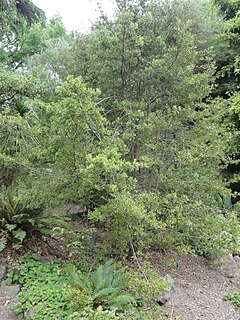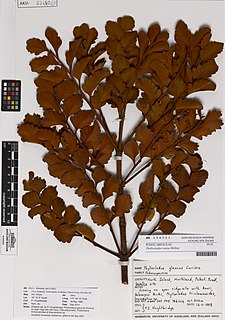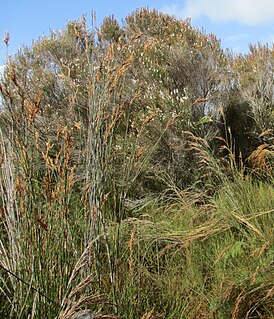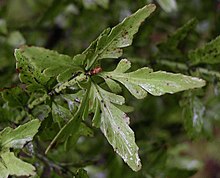
Dacrydium cupressinum, commonly known as rimu, is a large evergreen coniferous tree endemic to the forests of New Zealand. It is a member of the southern conifer group, the podocarps. The former name "red pine" has fallen out of common use.

Podocarpaceae is a large family of mainly Southern Hemisphere conifers, comprising about 156 species of evergreen trees and shrubs. It contains 19 genera if Phyllocladus is included and Manoao and Sundacarpus are recognized.

Phyllocladus, the celery pines, is a small genus of conifers, now usually treated in the family Podocarpaceae.Species occur mainly in New Zealand, Tasmania, and Malesia in the Southern Hemisphere, though P. hypophyllus ranges into the Philippines, a short way north of the equator.

The Tasmanian temperate rain forests are a temperate broadleaf and mixed forests ecoregion in western Tasmania. The ecoregion is part of the Australasian realm, which includes Tasmania and Australia, New Zealand, New Guinea, New Caledonia, and adjacent islands.

Pseudowintera is a genus of woody evergreen flowering trees and shrubs, part of family Winteraceae. The species of Pseudowintera are native to New Zealand. Winteraceae are magnoliids, associated with the humid Antarctic flora of the southern hemisphere. Horopito can be chewed for a hot, peppery taste.

Lomatia tasmanica, commonly known as King's lomatia, is a shrub of the family Proteaceae native to Tasmania. Growing up to 8 metres (26 ft) tall, the plant has shiny green pinnate (lobed) leaves and bears red flowers in the summer, but yields neither fruit nor seeds. King's lomatia is unusual because all of the remaining plants are genetically identical clones. Because it has three sets of chromosomes and is therefore sterile, reproduction occurs only vegetatively: when a branch falls, that branch grows new roots, establishing a new plant that is genetically identical to its parent.

Dracophyllum is a genus of plants belonging to the family Ericaceae, formerly Epacridaceae. There are some one hundred or so species in the genus, mostly shrubs, but also cushion plants and trees, found in New Zealand, Australia, Lord Howe Island and New Caledonia. The name Dracophyllum, meaning dragon-leaf, refers to their strong similarity to the unrelated Dracaena, sometimes known as dragon tree. Although dicotyledonous, they resemble primitive monocots with their slender leaves concentrated in clumps at the ends of the branches; they are sometimes called grass-trees.

Phyllocladus trichomanoides, the tanekaha or celery pine, is a coniferous tree endemic to New Zealand.

Phyllocladus toatoa, known as toatoa (Māori) or blue celery pine is a species of conifer in the family Podocarpaceae, endemic to New Zealand. It was formerly referred to as P. glaucus.

Melicytus is a genus of flowering plants in the family Violaceae. Hymenanthera is a synonym.
Pittosporum patulum is a plant species endemic to New Zealand where it has a restricted distribution in the South Island - ranging from Nelson in the north with occurrences in inland Marlborough down to Wanaka in the south. It is unusual amongst the genus in having deep red and scented flowers.

Peraxilla tetrapetala, or red mistletoe, is a parasitic plant in the family Loranthaceae, endemic to New Zealand and found on both the North and South Islands. The Māori names for the plant are pikirangi, pirirangi and roeroe.

Archeria is a small genus of shrubs in the family Ericaceae. As currently circumscribed the group includes six species, all native to southern Australasia. Four of these are endemic to Tasmania, and the other two endemic to New Zealand.

Archeria traversii is a species of shrub in the family Ericaceae.

Archeria racemosa is a species of shrub in the family Ericaceae.

Sporadanthus ferrugineus, the bamboo rush or giant wire rush, is a plant endemic to New Zealand. In 2011, it was voted "Plant of the Year" in a poll run by the New Zealand Plant Conservation Network. Described in 1999, S. ferrugineus was first considered to be the same species as Sporadanthus traversii which is native to northern parts of the Chatham Islands to the south of New Zealand and the Southern Tablelands in Australia. S. ferrugineus is the only known food source for the moth Houdinia flexilissima.

Dracophyllum longifolium, commonly called inaka, is an upright shrub or small tree in the family Ericaceae that is endemic to New Zealand.

Pseudowintera traversii, sometimes called Travers horopito, is a species of woody shrub in the family Winteraceae. The specific epithet traversii is in honor of naturalist Henry H. Travers (1844-1928), son of William Thomas Locke Travers.

Dracophyllum traversii, commonly known as mountain neinei, grass tree, and pineapple tree is a tree endemic to New Zealand that grows from 0.2–13 m tall. Its leaves form tufts at the end of branches, like that of species in the family Bromeliaceae.


















